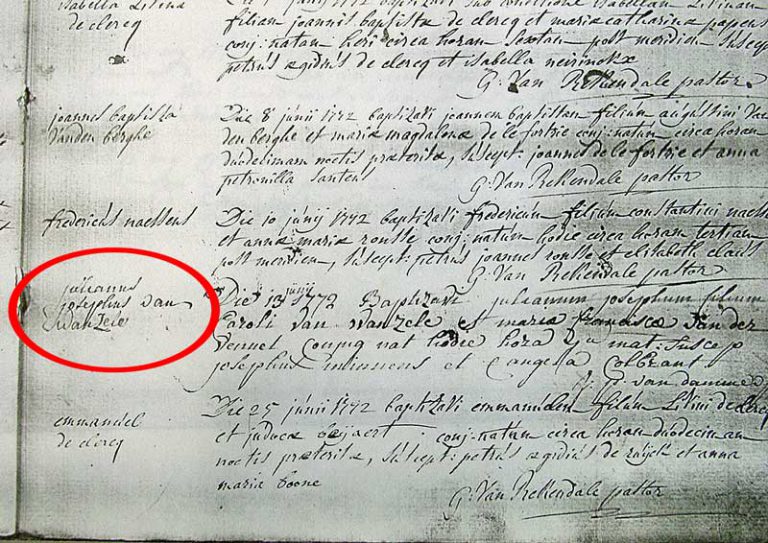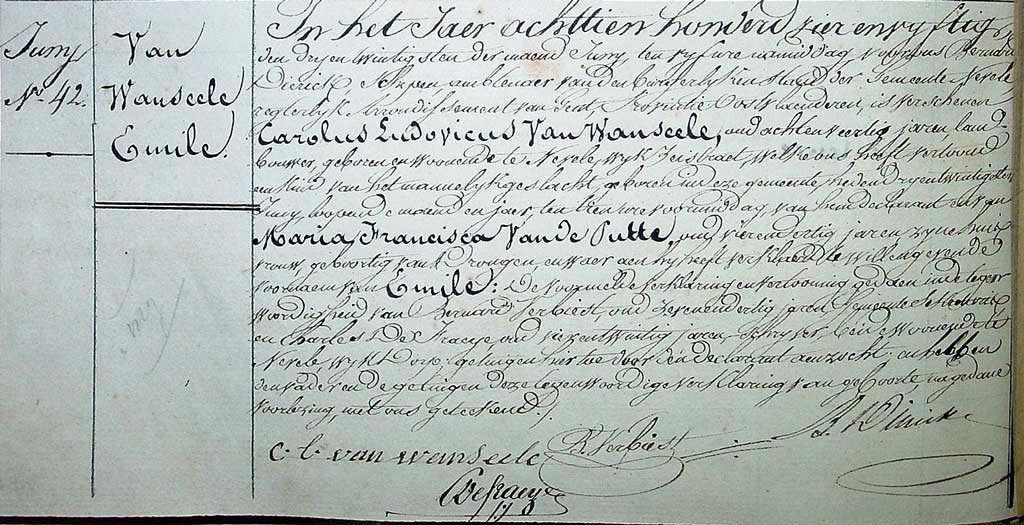NAMES
Van Wanseele or Van Wanzeele? Some ancestors are born as Van Wanzeele and die as Van Wanseele or vice versa. In other cases the marriage certificate mentions Van Wanseele but the signature of the groom is Van Wanzeele. Today both names are equally found and concentrated near Ghent in the province East Flanders, Belgium.
The most common names in Flanders are Peeters (33.000),Janssens (31.000) and Maes (25.000). With only 189 instances Van Wanseele and Van Wanzeele are uncommon names.
Traditional family names in Belgium can be classified in several categories of meaning. The place of origin is one such category. It is indicated by “van” , which means “from” or “of”. Most of the surnames in this category match a village, town or region’s name. This is the case for Van Wanzeele, referring to Wanzele, a town near Ghent. In most cases it means that the family was noble and ruled over the land of that area in medieval times. Unfortunatily, this is not the case for Van Wanzeele or Van Wanseele.


There is a variety of reasons why the spelling of surnames changed over generations or even in one lifetime. Some are historical, others are regional and some are purely accidental. The 19th century is a also period of transition from an oral to a written society. Furthermore in Flemish, unlike in Dutch, the pronunciation of ‘z’ and ‘s’ is very similar.
The nature of Flemish Dutch around 1800 is usually described as a collection of dialects. Contrary to the situation in Holland, there was no widely accepted standard Dutch which could be used for supraregional communication – in general, French was used for such purposes instead. In sum, spelling standardization was unimportant to the majority in Flanders in the 19th century.
BEFORE 1796 CATHOLIC CHURCH REGISTERS
It was not until after the Council of Trent (1545-1563) that parish priests in Europe were required to keep records of all baptisms and marriages. In the Southern Netherlands (Belgium), this recording became obligatory in 1564 but was still very irregularly applied. In their Eternal Edict (1611) the rulers of Flanders, Albert and Isabella ordered the aldermen of towns and villages throughout their reign to make copies of all church records. Thus the parish registers were preserved as two separate sources: church and magistracy. Except for some very early records, all were written in Latin.

JULIANUS JOSEPHUS VAN WANZELE
Die 13 junii 1772 baptizati julianum josephum filium Caroli Van Wanzele et maria francisca Van der Vennet conjug nat hodie hora (…) mat suscep josephus minssens et angela colbrant.
JULIANUS JOSEPHUS VAN WANZELE
The 13th of June 1772 is baptised Julianus Josephus, son of Carolus Van Wanzele and Maria Francisca Van der Vennet, spouses, born this day at (…) in the morning godparents josephus (…) and angela (…).
1796 – 1805 REPUBLICAN CIVIL REGISTER
In 1795, Belgium was annexed by France. Napoleon Bonaparte instituted the civil registration of births, marriages, and deaths. Civil registration in French occurs on a town-by-town basis. Many of the earliest records from this time follow the French Revolutionary calendar established in France in October 1793 and abolished by Napoleon on January 1, 1806
Here is a handy conversion tool. I.c. l’an treize 28 thermidor = 1805 16th of August.
It was not unusual to replace formerly Latin names with French names, i.c. August for Augustus, Charles for Carolus, François for Franciscus, Louis for Ludovicus, etc.

CHARLES LOUIS VAN WANSEELE
L’an treize le vingt huit thermidor à neuf heures du matin par devant nous Fosse Albert ( ) adjoint au maire, officier de l’Etat Civil à la commune de Nevele chef lieu du canton département de l’Escaut est comparu Julien Joseph Van Wanseele agé de trentre trois ans cultivateur demeurant à Nevele, lequel nous a présenté un enfant du sexe masculin, né le vingt six du mois à quatre heures ( ) de lui, déclarant, et de thérèse Van Gansbeke agée de vingt quatre ans, son épouse, et auquel il a déclaré de vouloir donner les prénoms de Charles Louis, les dites déclaration et présentation faites en présence de Dupuis Fredericq agé de vingt sept ans, écrivain à Nevele et Bernard Thuys agé de trente sept ans garde champetre à Nevele; et ont, le père et témoins, signé avec nous le présent acte après qu’il leur en a été fait lecture. (signatures)
CHARLES LOUIS VAN WANSEELE
In the year thirteen the twenty eighth Thermidor at nine in the morning before me Albert ( ) Deputy Mayor, officer of the Civil State in the municipality of Nevele head of the canton of the Scheldt department appeared Julien Joseph Van Wanseele aged thirty three years farmer living in Nevele, which showed us a male child, born the twenty sixth of this month at four a’clock () him, declaring, and Thérèse Van Gansbeke aged twenty four, his wife, and to whom he declared to want to give the names of Charles Louis, the said deposition and presentation being made in the presence of Dupuis Fredericq aged twenty seven writer at Nevele and Bernard Thuys aged thirty-seven rural constable at Nevele; and, the father and witnesses , having signed with us this deed after it was read out to them. (Signatures)
1805 – END 19TH CENTURY OLD REGISTER
These civil records are the primary source for research after 1796. They are recorded by either the mayor himself or a government clerk within 3 days of the event. They are generally correct as far as the information goes, as the events were registered by eyewitnesses of the event. Barring spelling errors or faulty memory, civil records are as accurate as possible.
After the defeat of Napoleon at Waterloo in 1815 the country was unified with the Netherlands for 15 years before becoming an independent nation in 1830. Although French was the language of public administration and the bourgeoisie, civil records in Flanders were listed in Dutch.

Emile Van Wanseele
In het jaar achttien honderd vierenvijftig, den drijentwintigsten der maand juni, ten vijf ure namiddag, voor ons Bernard Dierick, schepen, ambtenaer van den burgerlijken stand der gemeente Nevele, regterlijk Arrondissement van Gent, provincie Oostvlaanderen, is verschenen Carolus Ludovicus Van Wanseele,oud achtenveertig jaren, landbouwer, geboren en woonende te Nevele, wijk Zeistraat, welke ons heeft vertoond een kind van het mannelijk geslacht, geboren in deze gemeente heden drijentwintigsten Juni, loopende maand en jaar, ten tien ure voormiddag, van hem, declarant, en Maria Francisca Vande Putte, oud vierendertig jaren, zijn huisvrouw, geboortig van Drongen, en waer aen hij heeft verklaard te willen geven de voornaam van Emile. De voormelde verklaring en vertooning gedaan in de tegenwoordigheid van Bernard Verbiest, oud zevenendertig jaren, gemeente(…), en Charles De Fraeye vierentwintig jaren, schrijver en woonachtig te Nevele wijk Dorp, getuigen hiertoe door de declarant aanzocht, en hebben den vader en de getuigen deze tegenwoordige verklaring van geboorte, na gedane voorlezing, met ons getekend. (handtekeningen)
Emile Van Wanseele
This excerpt is a declaration of birth, written in old and formal Dutch.
It states that on June 23, 1854, Carolus Ludovicus Van Wanseele, male, 48 years old, farmer, came to declare the birth of his son Emile. The name of the mother was Maria Francisca Vande Putte, 34 years old, housewife. The officer of the civil registry was Bernard Dierick. His witnesses were Bernard Verbiest, 37 years old, and Charles De Fraeye, 24 years old. It says that all of them present signed the declaration.